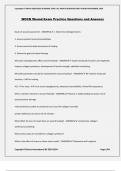Copyright © KAYLIN 2024/2025 ACADEMIC YEAR. ALL RIGHTS RESERVED FIRST PUBLISH NOVEMBER, 2024
WOCN Wound Exam Practice Questions and Answers
Goals of wound assessment - ANSWER✔✔-1. Determine etiologic factors
2. Assess systemic factors/comorbidities
3. Assess wound to determine phase of healing
4. Determine goals of topical therapy
Why does hyperglycemia affect wound healing? - ANSWER✔✔-Impairs leukocyte function and negatively
impacts collagen syntehesis, development of tensile strength, epithelial resurfacing
What BG parameters should be maintained for wound healing? - ANSWER✔✔-BG <180 for leukocyte
function; <140 for healing
A1C <7 for most, <8 if hx of severe hypoglycemia, advanced comorbidities, limited life expectancy
Why is nutrition relevant to wound healing? - ANSWER✔✔-Muscle or SubQ wasting increases risk of
pressure/shear damage
malnourished pt unable to synthesize and cross-link collagen normally
protein deficiency increases risk of infection
What effect do low zinc levels have on wound healing? - ANSWER✔✔-compromise collagen
synthesis/crosslinking
What amino acids are essential for collagen synthesis?
What is the effect of stress on these amino acids? - ANSWER✔✔-Glutamine and l-arginine
Copyright ©Stuvia International BV 2010-2024 Page 1/64
,Copyright © KAYLIN 2024/2025 ACADEMIC YEAR. ALL RIGHTS RESERVED FIRST PUBLISH NOVEMBER, 2024
Not adequately produced during times of physiologic stress
What weight trend suggests nutritional deficiency? - ANSWER✔✔-Unplanned weight loss =>2.5% of
usual weight in 30 days or =>10% within 180 days
BMI <18.5
What serum albumin level indicates malnutrition? - ANSWER✔✔-<3.5 g/dl
What serum transferrin level indicates malnutrition? - ANSWER✔✔-<100mg/dl
What serum prealbumin level indicates malnutrition? - ANSWER✔✔-<19.5
What total lymphocyte count level indicates malnutrition? - ANSWER✔✔-<1500
What are s/s of nutritional deficits? - ANSWER✔✔-skin rashes, cracks in mucous membranes, edema,
muscle and subQ tissue wasting, nonhealing wounds, dry/pluckable hair, dry flaky itchy skin
What is the suggested caloric intake? - ANSWER✔✔-30-35 cal/kg body weight
What is the suggested protein intake? - ANSWER✔✔-1.25-1.5 g/kg body weight
What is the suggested fluid intake? - ANSWER✔✔-30ml per kg (unless fluid restriction indicated)
How do you assess perfusion/oxygenation? - ANSWER✔✔-capillary refill, pulses, presence/absence of
edema, TcpO2 levels (at least 40), color of wound bed (bright pink/red), ABI for lower extremity ulcers,
systolic bp/episodes of hypotension, vasopressor administration
How do you assess for immunosuppression? - ANSWER✔✔-Comorbidities/therapies such as HIV, steroid
tehrapy in doses >30mg/day for >30 days, and/or chemo resulting in neutropenia; high dose NSAIDs
Copyright ©Stuvia International BV 2010-2024 Page 2/64
,Copyright © KAYLIN 2024/2025 ACADEMIC YEAR. ALL RIGHTS RESERVED FIRST PUBLISH NOVEMBER, 2024
What comorbidities compromise wound healing? - ANSWER✔✔-renal failure, liver failure, multisystem
trauma, smoking, advanced age
What are the layers of the skin - ANSWER✔✔-Epidermis
Basement Membrane Zone
Dermis
Subcutaneous Tissue
Muscle/Fascia/Bone
What are the layers of the epidermis? - ANSWER✔✔-Stratum corneum - keratinocytes filled with keratin
Stratum lucidum - only in palms/soles, thick areas
Stratum granulosum - odland bodies secrete ceramides, lipophilic
Stratum spinosum - desmosomes (cell to cell junctions)
Stratum germinativum - dermal-epidermal junction
What is the Basement Membrane Zone? - ANSWER✔✔-Dermal-epidermal junction
What are the components of the dermis? - ANSWER✔✔-Papillary dermis: papillae interlock with rete
ridges, capillary loops, sensitive to point pressure
Reticular dermis: mostly type 1 collagen, vasculars, and lymphatics
What structures of the skin can regenerate? - ANSWER✔✔-Epidermis and parts of the dermis
What structures of the skin heal by scar formation? - ANSWER✔✔-Epidermal appendages, Subcutaneous
tissue/fascia/muscle
Copyright ©Stuvia International BV 2010-2024 Page 3/64
, Copyright © KAYLIN 2024/2025 ACADEMIC YEAR. ALL RIGHTS RESERVED FIRST PUBLISH NOVEMBER, 2024
How is newborn skin different? - ANSWER✔✔-No scars up to 2nd trimester
30% thinner skin
Faster epidermal turnover
How is premature infant skin different? - ANSWER✔✔-Very thin, increased fluid loss, functional stratum
corneum at 30-32 weeks
What problems may arise with infant skin? - ANSWER✔✔-increased permeability, increased MARSI risk,
extravasation, diaper dermatitis
How do you mitigate MARSI risk in infants/elderly? - ANSWER✔✔-avoid tape or use hydrocolloid base or
silicone adhesive, no alcohol removers only mineral oil, petroleum, silicone (preferred), and citrus)
How do you mitigate extravasation in an infant? - ANSWER✔✔-Hyaluronidase
OR
phentolamine if vasoconstrictor
How do you mitigate diaper dermatitis? - ANSWER✔✔-Higher pH
Use petroleum base for mild erythema and zinc oxide for denuded skin
sever denudation - carboxymethylcellulose/petrolatum/zinc oxide (Ilex)
What bathing considerations must you take for premature infants? - ANSWER✔✔-<30 weeks bathe with
water only for 2 weeks
What are common issues with older skin? - ANSWER✔✔-Thinner, collagen shrinks and causes wrinkles
Rete ridges and dermal papillae flatten - increased risk for tears/stripping
Copyright ©Stuvia International BV 2010-2024 Page 4/64




